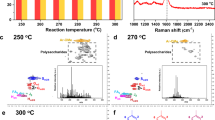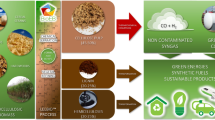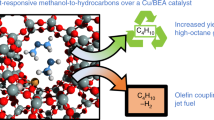Abstract
There is an urgent need to address environmental problems caused by our transportation systems, which include the reduction of associated CO2 emissions. In the short term, renewable drop-in fuels are ideal, as they allow a direct integration into the existing infrastructure. However, preferably they would perform better than current alternatives (for example, bioethanol) and be synthesized in a more efficient way. Here we demonstrate the production of biogasoline with a direct upstream integration into processes in existing petrorefinery facilities that targets the 10% bio-based carbon in accordance with the current European Union directives (for 2020) for biofuels. To achieve this goal, we show the valorization of (hemi)cellulose pulp into light naphtha using a two-phase (H2O:organic) catalytic slurry process. A C5–C6 alkane stream, enriched with bio-derived carbon and compatible with further downstream petrorefinery operations for (bio)gasoline production, is automatically obtained by utilizing fossil light straight run naphtha as the organic phase. The ease of integration pleads for a joint petro/bio effort to gradually produce bio-enriched gasolines, wherein the chemical compounds of the bio-derived fraction are indistinguishable from those in current high-quality gasoline compositions.
This is a preview of subscription content, access via your institution
Access options
Access Nature and 54 other Nature Portfolio journals
Get Nature+, our best-value online-access subscription
$29.99 / 30 days
cancel any time
Subscribe to this journal
Receive 12 digital issues and online access to articles
$119.00 per year
only $9.92 per issue
Buy this article
- Purchase on Springer Link
- Instant access to full article PDF
Prices may be subject to local taxes which are calculated during checkout





Similar content being viewed by others
Data availability
Supplementary Information gives additional and supporting data. Further data that support the plots within this paper and other findings of this study are available from the corresponding author upon reasonable request.
References
Huber, G. W., Iborra, S. & Corma, A. Synthesis of transportation fuels from biomass: chemistry, catalysts, and engineering. Chem. Rev. 106, 4044–4098 (2006).
Climent, M. J., Corma, A. & Iborra, S. Conversion of biomass platform molecules into fuel additives and liquid hydrocarbon fuels. Green Chem. 16, 516–547 (2014).
Wang, G. H. et al. Nitrogen-doped ordered mesoporous carbon supported bimetallic PtCo nanoparticles for upgrading of biophenolics. Angew. Chem. Int. Ed. 55, 8850–8855 (2016).
Corma, A., Iborra, S. & Velty, A. Chemical routes for the transformation of biomass into chemicals. Chem. Rev. 107, 2411–2502 (2007).
Rinaldi, R. et al. Paving the way for lignin valorisation: recent advances in bioengineering, biorefining and catalysis. Angew. Chem. Int. Ed. 55, 8164–8215 (2016).
Schutyser, W. et al. Chemicals from lignin: an interplay of lignocellulose fractionation, depolymerisation, and upgrading. Chem. Soc. Rev. 47, 852–908 (2018).
Dusselier, M., Mascal, M. & Sels, B. in Selective Catalysis for Renewable Feedstocks and Chemicals (ed. Nicholas, K. M.) 1–40 (Springer International Publishing, Heidelberg, 2014).
Deneyer, A. et al. Alkane production from biomass: chemo-, bio- and integrated catalytic approaches. Curr. Opin. Chem. Biol. 29, 40–48 (2015).
Alonso, D. M., Bond, J. Q. & Dumesic, J. A. Catalytic conversion of biomass to biofuels. Green Chem. 12, 1493–1513 (2010).
Nguyen, Q. et al. Global Production of Second Generation Biofuels: Trends and Influences (Dovetail Partners Inc., Minneapolis, 2017).
Melton, N., Axsen, J. & Sperling, D. Moving beyond alternative fuel hype to decarbonize transportation. Nat. Energy 1, 16013 (2016).
The European Parliament and the Council of the European Union Directive 2009/28/EC of the European Parliament and of the Council of 23 April 2009 on the Promotion of the Use of Energy from Renewable Sources and Amending and Subsequently Repealing Directives 2001/77/EC and 2003/30/EC (European Union, 2009).
Sarrazin, P., Colin, B. & Martino, G. in Handbook of Heterogeneous Catalysis (eds Ertl, G., Knözinger, H., Schüth, F. & Weitkamp, J.) Part 13.1 (Wiley-VCH, Weinheim, 2008).
Román-Leshkov, Y., Barrett, C. J., Liu, Z. Y. & Dumesic, J. A. Production of dimethylfuran for liquid fuels from biomass-derived carbohydrates. Nature 447, 982–985 (2007).
Jenkins, R. W. et al. The effect of functional groups in bio-derived fuel candidates. ChemSusChem 9, 922–931 (2016).
Molino, A., Chianese, S. & Musmarra, D. Biomass gasification technology: the state of the art overview. J. Energy Chem. 25, 10–25 (2016).
Baliban, R. C. et al. Hardwood biomass to gasoline, diesel, and jet fuel: 1. Process synthesis and global optimization of a thermochemical refinery. Energy Fuels 27, 4302–4324 (2013).
Venkatakrishnan, V. K., Delgass, W. N., Ribeiro, F. H. & Agrawal, R. Oxygen removal from intact biomass to produce liquid fuel range hydrocarbons via fast-hydropyrolysis and vapor-phase catalytic hydrodeoxygenation. Green Chem. 17, 178–183 (2015).
Kan, T., Strezov, V. & Evans, T. J. Lignocellulosic biomass pyrolysis: a review of product properties and effects of pyrolysis parameters. Renew. Sustain. Energy Rev. 57, 126–1140 (2016).
Lange, J.-P. Lignocellulose liquefaction to biocrude—a tutorial review. ChemSusChem 11, 997–1014 (2018).
Jahangiri, H., Bennett, J., Mahjoubi, P., Wilson, K. & Gu, S. A review of advanced catalyst development for Fischer–Tropsch synthesis of hydrocarbons from biomass derived syn-gas. Catal. Sci. Technol. 4, 2210–2229 (2014).
Liu, S., Tamura, M., Nakagawa, Y. & Tomishige, K. One-pot conversion of cellulose into n-hexane over the Ir–ReOx/SiO2 catalyst combined with HZSM-5. ACS Sustain. Chem. Eng. 2, 1819–1827 (2014).
Op de Beeck, B. et al. Direct catalytic conversion of cellulose to liquid straight-chain alkanes. Energy Environ. Sci. 8, 230–240 (2015).
Liu, S. et al. Selective transformation of hemicellulose (xylan) into n-pentane, pentanols or xylitol over Ir–ReOx/SiO2 catalyst combined with acids. Green Chem. 18, 165–175 (2016).
Xia, Q. et al. Direct hydrodeoxygenation of raw woody biomass into liquid alkanes. Nat. Commun. 7, 11162 (2016).
Valavarasu, G. & Sairam, B. Light naphtha isomerization process: a review. Pet. Sci. Technol. 31, 580–592 (2013).
Liu, Y. et al. One-pot catalytic conversion of raw lignocellulosic biomass into gasoline alkanes and chemicals over LiTaMoO6 and Ru/C in aqueous phosphoric acid. ACS Sustain. Chem. Eng. 3, 1745–1755 (2015).
Schwartz, T. J. et al. Engineering catalyst microenvironments for metal-catalyzed hydrogenation of biologically derived platform chemicals. Angew. Chem. Int. Ed. 53, 12718–12722 (2014).
Swan, T. S. in Handbook of Heterogeneous Catalysis (eds. Ertl, G., Knözinger, H., Schüth, F. & Weitkamp, J.) Part 13.7 (Wiley-VCH, Weinheim, 2008).
Jechura, J. Gasoline Upgrading: Reforming, Isomerization, & Alkylation (Colorado School of Mines, 2017).
Jechura, J. Refinery Feedstocks & Products: Properties & Specifications (Colorado School of Mines, 2017).
Kozhevnikov, I. V. Catalysis by heteropoly acids and multicomponent polyoxometalates in liquid-phase reactions. Chem. Rev. 98, 171–198 (1998).
Timofeeva, M. N. Acid catalysis by heteropoly acids. Appl. Catal. A 256, 19–35 (2003).
Mohd Azhar, S. H. et al. Yeasts in sustainable bioethanol production: a review. Biochem. Biophys. Rep. 10, 52–61 (2017).
Hatch, L. F. & Matar, S. From Hydrocarbons to Petrochemicals (Gulf Publishing Co, Houston, 1981).
Izumi, Y., Hasebe, R. & Urabe, K. Catalysis by heterogeneous supported heteropoly acid. J. Catal. 84, 402–409 (1983).
Román-Leshkov, Y., Chheda, J. N. & Dumesic, J. A. Phase modifiers promote efficient production of hydroxymethylfurfural from fructose. Science 312, 1933–1937 (2006).
Román-Leshkov, Y. & Dumesic, J. A. Solvent effects on fructose dehydration to 5-hydroxymethylfurfural in biphasic systems saturated with inorganic salts. Top. Catal. 52, 297–303 (2009).
Saha, B. & Abu-Omar, M. M. Advances in 5-hydroxymethylfurfural production from biomass in biphasic solvents. Green Chem. 16, 24–38 (2014).
Schatzberg, P. Solubilities of water in several normal alkanes from C7 to C16. J. Phys. Chem. 67, 776–779 (1963).
Tsonopoulos, C. & Wilson, G. M. High‐temperature mutual solubilities of hydrocarbons and water. Part I: Benzene, cyclohexane and n‐hexane. AIChE J. 29, 990–999 (1983).
Heidman, J. L., Tsonopoulos, C., Brady, C. J. & Wilson, G. M. High-temperature mutual solubilities of hydrocarbons and water. Part II: Ethylbenzene, ethylcyclohexane, and n-octane. AIChE J. 31, 376–384 (1985).
Tsonopoulos, C. Thermodynamic analysis of the mutual solubilities of hydrocarbons and water. Fluid Phase Equilib. 156, 21–33 (1999).
Galkin, M. V. & Samec, J. S. M. Lignin valorization through catalytic lignocellulose fractionation: a fundamental platform for the future biorefinery. ChemSusChem 9, 1544–1558 (2016).
Garrett, M. D., Bennett, S. C., Hardacre, C., Patrick, R. & Sheldrake, G. N. New methods in biomass depolymerisation: catalytic hydrogenolysis of barks. RSC Adv. 3, 21552–21557 (2013).
Renders, T., Van den Bosch, S., Koelewijn, S.-F., Schutyser, W. & Sels, B.F. Lignin-first biomass fractionation: the advent of active stabilisation strategies. Energy Environ. Sci. 10, 1551–1557 (2017).
Van den Bosch, S. et al. Reductive lignocellulose fractionation into soluble lignin-derived phenolic mono- and dimers and processable carbohydrate pulp. Energy Environ. Sci. 8, 1748–1763 (2015).
Shuai, L. et al. Formaldehyde stabilization facilitates lignin monomer production during biomass depolymerization. Science 354, 329–333 (2016).
Van den Bosch, S. et al. Integrating lignin valorization and bio-ethanol production: on the role of Ni–Al2O3 catalyst pellets during lignin-first fractionation. Green Chem. 19, 3313–3326 (2017).
Deneyer, A. et al. Compositional and structural feedstock requirements of a liquid phase cellulose-to-naphtha process in a carbon- and hydrogen-neutral biorefinery context. Green Chem. 18, 5594–5606 (2016).
Verboekend, D., Liao, Y., Schutyser, W. & Sels, B. F. Alkylphenols to phenol and olefins by zeolite catalysis: a pathway to valorize raw and fossilized lignocellulose. Green Chem. 18, 297–306 (2015).
Koelewijn, S.-F. et al. Sustainable bisphenols from renewable softwood lignin feedstock for polycarbonates and cyanate ester resins. Green Chem. 19, 2561–2570 (2017).
Koelewijn, S.-F. et al. Promising bulk production of a potentially benign bisphenol. A replacement from a hardwood lignin platform. Green Chem. 20, 1050–1058 (2018).
Pasadakis, N., Gaganis, V. & Foteinopoulos, C. Octane number prediction for gasoline blends. Fuel Process. Technol. 87, 505–509 (2006).
Acknowledgements
This work was performed in the framework of the IWT-SBO project ARBOREF. A.D. acknowledges the Agency for Innovation by Science and Technology (IWT) for a PhD grant. E.P. and T.R. acknowledge Research Foundation-Flanders (FWO) for financial support. S.V.d.B. and T.E. acknowledge KU Leuven for a BOF-PDM grant. M.D. acknowledges FWO and BOFZAP. B. Op de Beeck is thanked for the initial exploratory work.
Author information
Authors and Affiliations
Contributions
M.D., B.F.S. and A.D. conceived the LPCtoN integration. Most experimental work (catalyst preparation, SEM, LPCtoN reactions and GC analysis) was performed by A.D., assisted by E.P. Experimental work with the RCF was performed by T.R. and S.V.d.B. The hydro-isomerization experimental work was performed by A.D and T.E., assisted by N.V.O. The 14C determination was performed by T.S. and T.I.K. Data analysis and writing was done by A.D. supported with the critical input of M.D. and B.F.S.
Corresponding authors
Ethics declarations
Competing interests
M.D. and B.F.S. have a pending patent (WO2015172208A1) on the LPCtoN technology. The other authors declare no competing interests.
Additional information
Publisher’s note: Springer Nature remains neutral with regard to jurisdictional claims in published maps and institutional affiliations.
Supplementary information
Supplementary Information
Supplementary Notes 1–9, Supplementary Figures 1–19, Supplementary Tables 1–8, Supplementary References
Rights and permissions
About this article
Cite this article
Deneyer, A., Peeters, E., Renders, T. et al. Direct upstream integration of biogasoline production into current light straight run naphtha petrorefinery processes. Nat Energy 3, 969–977 (2018). https://doi.org/10.1038/s41560-018-0245-6
Received:
Accepted:
Published:
Issue Date:
DOI: https://doi.org/10.1038/s41560-018-0245-6
This article is cited by
-
Radical generation and fate control for photocatalytic biomass conversion
Nature Reviews Chemistry (2022)
-
Catalytic transfer hydrogenation of cellulose to hydrocarbons using straight-chain aliphatic hydrocarbon as a solvent
Biomass Conversion and Biorefinery (2021)
-
Enhanced photocatalytic alkane production from fatty acid decarboxylation via inhibition of radical oligomerization
Nature Catalysis (2020)
-
Visible-light-driven coproduction of diesel precursors and hydrogen from lignocellulose-derived methylfurans
Nature Energy (2019)
-
Bio-enriching gasoline
Nature Energy (2018)



